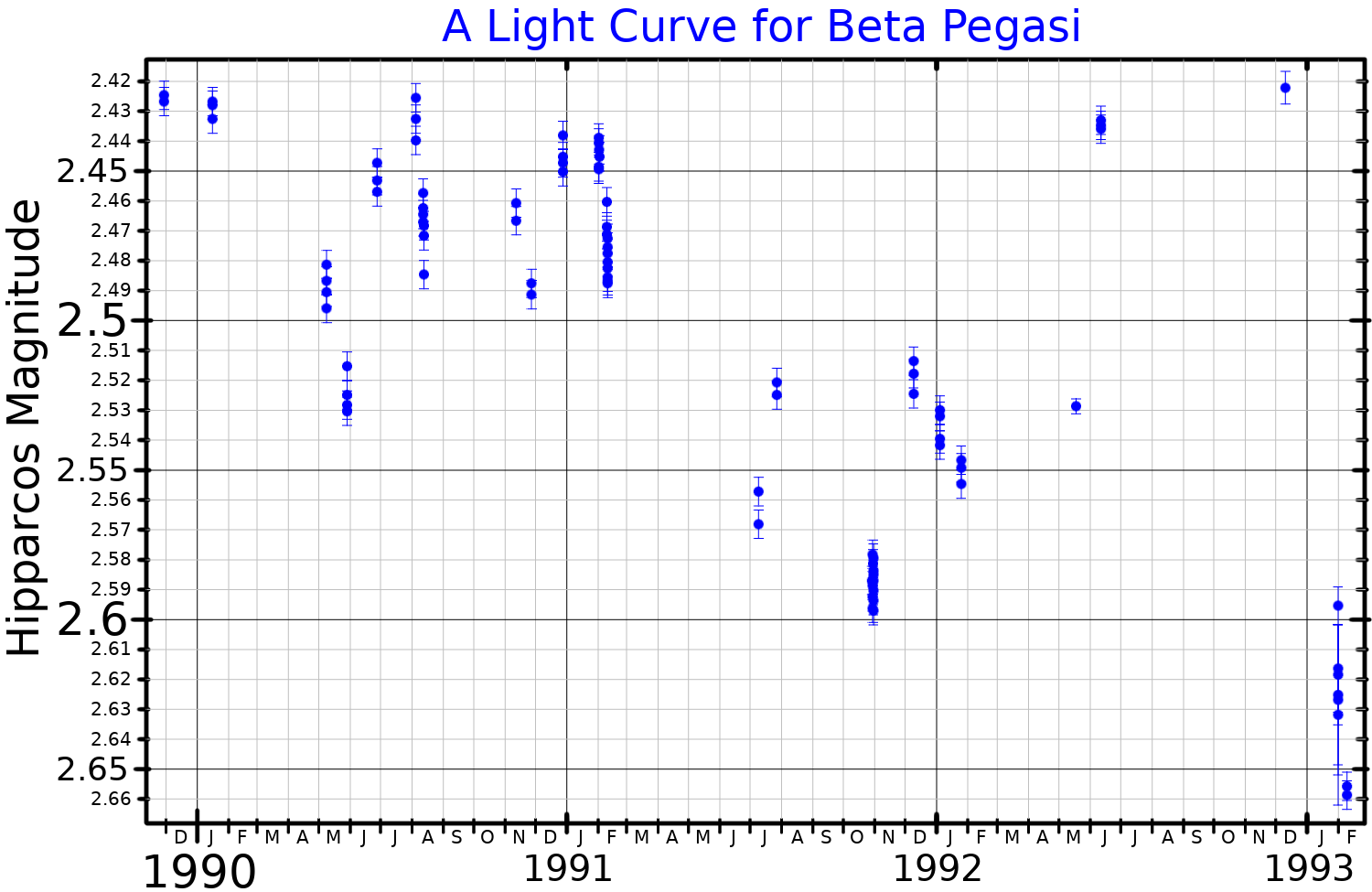|
öý Pegasi
Beta Pegasi (öý Pegasi, abbreviated Beta Peg, öý Peg), formally named Scheat , is a red giant star and the second-brightest star (after Epsilon Pegasi) in the constellation of Pegasus. It forms the upper right corner of the Great Square of Pegasus, a prominent rectangular asterism. Nomenclature ''öý Pegasi'' ( Latinised to ''Beta Pegasi'') is the star's Bayer designation. It bore the traditional name of ''Scheat'', a name that had also been used for Delta Aquarii. The name was derived from the Arabic ''Al Sá'id'' "the upper arm", or from ''Sa'd''. In 2016, the International Astronomical Union organised a Working Group on Star Names (WGSN) to catalog and standardise proper names for stars. The WGSN's first bulletin of July 2016 included a table of the first two batches of names approved by the WGSN; which included ''Scheat'' for this star (the name ''Skat'' was later approved for Delta Aquarii). In Chinese, (), meaning ''Encampment'', refers to an asterism consisti ... [...More Info...] [...Related Items...] OR: [Wikipedia] [Google] [Baidu] |
Pegasus (constellation)
Pegasus is a constellation in the northern sky, named after the winged horse Pegasus in Greek mythology. It was one of the 48 constellations listed by the 2nd-century astronomer Ptolemy, and is one of the IAU designated constellations, 88 constellations recognised today. With an apparent magnitude varying between 2.37 and 2.45, the brightest star in Pegasus is the orange supergiant Epsilon Pegasi, also known as Enif, which marks the horse's muzzle. Alpha Pegasi, Alpha (Markab), Beta Pegasi, Beta (Scheat), and Gamma Pegasi, Gamma (Algenib), together with Alpha Andromedae (Alpheratz) form the large Asterism (astronomy), asterism known as the ''Square of Pegasus''. Twelve star systems have been found to have exoplanets. 51 Pegasi was the first Sun-like star discovered to have an exoplanet companion. Mythology The Babylonian constellation IKU (field) had four stars of which three were later part of the Greek constellation ''Hippos'' (Pegasus). Pegasus, in Greek mythology, was a winge ... [...More Info...] [...Related Items...] OR: [Wikipedia] [Google] [Baidu] |
International Astronomical Union
The International Astronomical Union (IAU; , UAI) is an international non-governmental organization (INGO) with the objective of advancing astronomy in all aspects, including promoting astronomical research, outreach, education, and development through global cooperation. It was founded on 28 July 1919 in Brussels, Belgium and is based in Paris, France. The IAU is composed of individual members, who include both professional astronomers and junior scientists, and national members, such as professional associations, national societies, or academic institutions. Individual members are organised into divisions, committees, and working groups centered on particular subdisciplines, subjects, or initiatives. the Union had 85 national members and 12,734 individual members, spanning 90 countries and territories. Among the key activities of the IAU is serving as a forum for scientific conferences. It sponsors nine annual symposia and holds a triannual General Assembly that sets policy ... [...More Info...] [...Related Items...] OR: [Wikipedia] [Google] [Baidu] |
Effective Temperature
The effective temperature of a body such as a star or planet is the temperature of a black body that would emit the same total amount of electromagnetic radiation. Effective temperature is often used as an estimate of a body's surface temperature when the body's emissivity curve (as a function of wavelength) is not known. When the star's or planet's net emissivity in the relevant wavelength band is less than unity (less than that of a black body), the actual temperature of the body will be higher than the effective temperature. The net emissivity may be low due to surface or atmospheric properties, such as the greenhouse effect. Star The effective temperature of a star is the temperature of a black body with the same luminosity per ''surface area'' () as the star and is defined according to the StefanãBoltzmann law . Notice that the total ( bolometric) luminosity of a star is then , where is the stellar radius. The definition of the stellar radius is obviously not ... [...More Info...] [...Related Items...] OR: [Wikipedia] [Google] [Baidu] |
Luminosity
Luminosity is an absolute measure of radiated electromagnetic radiation, electromagnetic energy per unit time, and is synonymous with the radiant power emitted by a light-emitting object. In astronomy, luminosity is the total amount of electromagnetic energy emitted per unit of time by a star, galaxy, or other astronomical object, astronomical objects. In SI units, luminosity is measured in joules per second, or watts. In astronomy, values for luminosity are often given in the terms of the Solar luminosity, luminosity of the Sun, ''L''ã. Luminosity can also be given in terms of the astronomical Magnitude (astronomy), magnitude system: the Absolute magnitude#Bolometric magnitude, absolute bolometric magnitude (''M''bol) of an object is a logarithmic measure of its total energy emission rate, while absolute magnitude is a logarithmic measure of the luminosity within some specific wavelength range or Passband, filter band. In contrast, the term ''brightness'' in astronomy is gene ... [...More Info...] [...Related Items...] OR: [Wikipedia] [Google] [Baidu] |
Giant Star
A giant star has a substantially larger radius and luminosity than a main-sequence (or ''dwarf'') star of the same surface temperature. They lie above the main sequence (luminosity class V in the Yerkes spectral classification) on the HertzsprungãRussell diagram and correspond to luminosity classes II and III. The terms ''giant'' and ''dwarf'' were coined for stars of quite different luminosity despite similar temperature or spectral type (namely K and M) by Ejnar Hertzsprung in 1905 or 1906. Giant stars have radii up to a few hundred times the Sun and luminosities over 10 times that of the Sun. Stars still more luminous than giants are referred to as supergiants and hypergiants. A hot, luminous main-sequence star may also be referred to as a giant, but any main-sequence star is properly called a dwarf, regardless of how large and luminous it is. Formation A star becomes a giant after all the hydrogen available for fusion at its core has been depleted and, as a r ... [...More Info...] [...Related Items...] OR: [Wikipedia] [Google] [Baidu] |
Bright Giant
A giant star has a substantially larger radius and luminosity than a main-sequence (or ''dwarf'') star of the same surface temperature. They lie above the main sequence (luminosity class V in the Yerkes spectral classification) on the HertzsprungãRussell diagram and correspond to luminosity classes II and III. The terms ''giant'' and ''dwarf'' were coined for stars of quite different luminosity despite similar temperature or spectral type (namely K and M) by Ejnar Hertzsprung in 1905 or 1906. Giant stars have radii up to a few hundred times the Sun and luminosities over 10 times that of the Sun. Stars still more luminous than giants are referred to as supergiants and hypergiants. A hot, luminous main-sequence star may also be referred to as a giant, but any main-sequence star is properly called a dwarf, regardless of how large and luminous it is. Formation A star becomes a giant after all the hydrogen available for fusion at its core has been depleted and, as a result ... [...More Info...] [...Related Items...] OR: [Wikipedia] [Google] [Baidu] |
Stellar Spectrum
Astronomical spectroscopy is the study of astronomy using the techniques of spectroscopy to measure the spectrum of electromagnetic radiation, including visible light, ultraviolet, X-ray, infrared and radio waves that radiate from stars and other celestial objects. A stellar spectrum can reveal many properties of stars, such as their chemical composition, temperature, density, mass, distance and luminosity. Spectroscopy can show the velocity of motion towards or away from the observer by measuring the Doppler shift. Spectroscopy is also used to study the physical properties of many other types of celestial objects such as planets, nebulae, galaxies, and active galactic nuclei. Background Astronomical spectroscopy is used to measure three major bands of radiation in the electromagnetic spectrum: visible light, radio waves, and X-rays. While all spectroscopy looks at specific bands of the spectrum, different methods are required to acquire the signal depending on the freque ... [...More Info...] [...Related Items...] OR: [Wikipedia] [Google] [Baidu] |
Stellar Classification
In astronomy, stellar classification is the classification of stars based on their stellar spectrum, spectral characteristics. Electromagnetic radiation from the star is analyzed by splitting it with a Prism (optics), prism or diffraction grating into a spectrum exhibiting the Continuum (spectrum), rainbow of colors interspersed with spectral lines. Each line indicates a particular chemical element or molecule, with the line strength indicating the abundance of that element. The strengths of the different spectral lines vary mainly due to the temperature of the photosphere, although in some cases there are true abundance differences. The ''spectral class'' of a star is a short code primarily summarizing the ionization state, giving an objective measure of the photosphere's temperature. Most stars are currently classified under the MorganãKeenan (MK) system using the letters ''O'', ''B'', ''A'', ''F'', ''G'', ''K'', and ''M'', a sequence from the hottest (''O'' type) to the cool ... [...More Info...] [...Related Items...] OR: [Wikipedia] [Google] [Baidu] |
Parallax
Parallax is a displacement or difference in the apparent position of an object viewed along two different sightline, lines of sight and is measured by the angle or half-angle of inclination between those two lines. Due to perspective (graphical), foreshortening, nearby objects show a larger parallax than farther objects, so parallax can be used to determine distances. To measure large distances, such as the distance of a planet or a star from Earth, astronomers use the principle of parallax. Here, the term ''Stellar parallax, parallax'' is the semi-angle of inclination between two sight-lines to the star, as observed when Earth is on opposite sides of the Sun in its orbit. These distances form the lowest rung of what is called "the cosmic distance ladder", the first in a succession of methods by which astronomers determine the distances to celestial objects, serving as a basis for other distance measurements in astronomy forming the higher rungs of the ladder. Because parallax ... [...More Info...] [...Related Items...] OR: [Wikipedia] [Google] [Baidu] |
Chinese Star Names
Chinese star names ( Chinese: , ''xá¨ng mûÙng'') are named according to ancient Chinese astronomy and astrology. The sky is divided into star mansions (, ''xá¨ng xiû¿'', also translated as "lodges") and asterisms (, ''xá¨ng guán''). The ecliptic is divided into four sectors that are associated with the Four Symbols, guardians in Chinese mythology, and further into 28 mansions. Stars around the north celestial pole are grouped into three enclosures (, ''yuûÀn''). The system of 283 asterisms under the Three Enclosures and Twenty-Eight Mansions was established by Chen Zhuo of the Three Kingdoms period, who synthesized ancient constellations and the asterisms created by early astronomers Shi Shen, Gan De and Wuxian. Since the Han and Jin dynasties, stars have been given reference numbers within their asterisms in a system similar to the Bayer or Flamsteed designations, so that individual stars can be identified. For example, Deneb (öÝ Cyg) is referred to as (''Tián Já¨n Sû ... [...More Info...] [...Related Items...] OR: [Wikipedia] [Google] [Baidu] |
Alpha Pegasi
Alpha Pegasi (öÝ Pegasi, abbreviated Alpha Peg, öÝ Peg), formally named Markab , is the third-brightest star in the constellation of Pegasus and one of the four stars in the asterism known as the Great Square of Pegasus. Properties Alpha Pegasi has a stellar classification of A0 IV, indicating that it is an A-type subgiant star that has exhausted the hydrogen at its core and has evolved beyond the main sequence. Its spectrum has also been classified as B9V and B9.5III. It is rotating rapidly, with a projected rotational velocity of 130 km/s giving a lower bound on the azimuthal velocity along the star's equator. The effective temperature of the photosphere is about 10,000 K and the star has expanded to nearly five times the radius of the Sun, emitting 165 times as much energy as the sun. Nomenclature ''öÝ Pegasi'' ( Latinised to ''Alpha Pegasi'') is the star's Bayer designation. It bore the traditional name ''Markab'' (or ''Marchab''), which derived fr ... [...More Info...] [...Related Items...] OR: [Wikipedia] [Google] [Baidu] |





